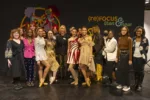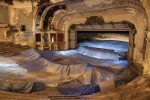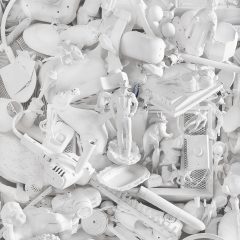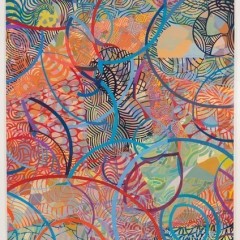From now until June 30, Hidden City Philadelphia is hosting its second Hidden City Festival. Over the Festival’s six weeks, unique historic sites around the city will be transformed by artists, allowing visitors to interact with urban space and history in novel and engaging ways. One of nine project sites scattered around the city is in the boiler room of Frankford’s old Globe Dye Works. Here in this relic of industrial infrastructure, artists the Dufala Brothers have created an installation called Oil & Water, which explores and blurs the line between contemporary technologies of production and outdated industry.
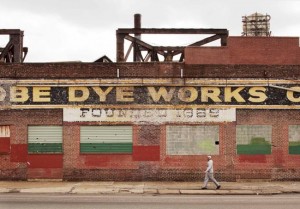
The Globe Dye works, built in 1865 and added onto continuously for the next 30 years, specialized in dyeing, bleaching, and winding cotton yarn for knitting mills and local weaving facilities in Philadelphia. The company was highly successful, adapting new technologies as industrial production evolved in the early 20th century, and seeing an especially large boom in business during the First World War when imported dyes could not reach America.
Originally relying on the local water supply both for power and as a dumping site, the Dye Works, like all developing industry, had an extremely tangled relationship with the physical landscape, the local community, and the unceasing fluctuations of global markets. While the Dufala Brothers do not explicitly comment on these factors with their installations, their subtle reconfigurations and intriguing additions to the space suggest an inquisitive attitude about these complicated issues.
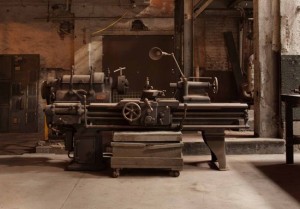
This should not be surprising, as the Dufala Brothers, both graduates of the Pennsylvania Academy of the Fine Arts, have a long demonstrated interest in repurposing cast-off technologies and materials in ways that make us think about the evolution of technology and the roles technology and industry play in our lives. Their site-specific creation for the Hidden City Festival is a fascinating, quirky exploration of the Dye Works, a space very much in transition as it is slowly “rehabilitated” and transformed from an industrial megalith into a network of artists studios and artisan production facilities.
The Dufala Brothers are interested not only in encouraging viewers to think deeply about both the physical infrastructure and impact of industry, but also seek to temporarily pause the ceaseless pace at which old industry is dismantled and new systems are built, allowing us to consider this practice more carefully.
Already partially dismantled and long disused, the artists hope to put “flesh back on the bones” of the Globe Dye Works, reminding viewers of the industrial history of the place before it is transformed into something else altogether.
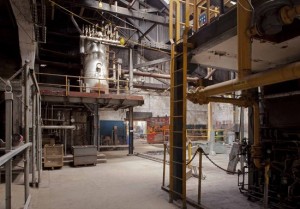
Although well worth exploring on its own, the boiler room of the Globe Dye Works is reconfigured and developed in often subtle ways by the Dufala Brothers, with engaging results. When you first enter the boiler room, you find yourself on a corrugated metal platform above the factory floor. Spread out in front, above, and below you is a vast amalgam of aged industrial components. Descending a metal staircase to the factory floor, visitors first encounter an enormous vat full of zeolite dust, once used during dye production in the factory.
From there, you can wander around the space, where giant machines of unknown design rear above you like strange mechanical Boabab trees. The industrial technology in this space is incomprehensible to the untrained eye; a maddening array of switches, dials, knobs, valves, caps, and meters adorn pipes and ducts that seem to lead everywhere and nowhere at once, while metal chambers stand hulking and massive all around.
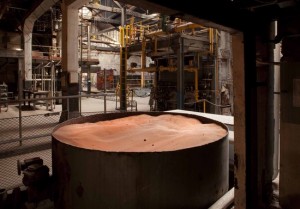
The Dufala Brothers use this overwhelming feeling as a jumping off point for their additions to the space. Many of these are subtle, even easy to miss. A small henge of rough-hewn wooden triangles, for example, sits quietly on a step in front of an actual industrial component, so unassuming that you might walk past it without even noticing.
At other times, you may find yourself wondering if a piece has been created by the artists, or is actually an original industrial component. For example, while it eventually becomes clear they are a part of the installation, a cluster of green hoses spilling snakelike from a cylindrical tank at first seem as if they are part of the device.
Some of Dufala Brothers contributions are more obvious. One wall is covered with salvaged ductwork, snaking from floor to ceiling. Two balls made from thick strands of tangled metal wire, reminiscent of massive balls of yarn, stand alone in one corner of the space, while a great tail of the same material spills out of a gap in the brick wall behind them and undulates across the floor. A towering cardboard cylinder stands in another corner, with cardboard piping rising out of it up to and along the ceiling, crudely tied to actual pipes and beams with rusty wire. These examples serve as both beautiful and playfully exaggerated references to the real industrial pieces around them.
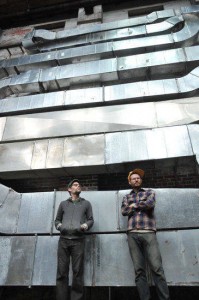
This variety, where some components are folded into the space while others stand out and instead frame the original infrastructure, is at the core of the installation.
The title of the show, Oil & Water, references the key natural resources needed to power the Globe Dye Works, but it also speaks to our inability to seamlessly integrate outdated technology and industry with future advances. This drives home the idea of the show as an exploration of the liminal space occupied by outdated industrial infrastructure, already moving toward disrepair and obsolescence from the moment it is built, and emphasizes the inherent placelessness of this technology.
The Dufala Brothers cleverly overtake this space, and with their often subtle reconfigurations ask us to think about our problematic relationship with industry and to reflect on the legacy and ongoing impact of our industrial past.
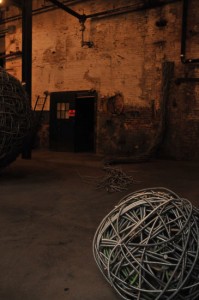
All photos courtesy of Hidden City Philadelphia. The Hidden City Festival runs from now until June 30. Festival passes, additional site information, and Hidden City membership information can be found here.



